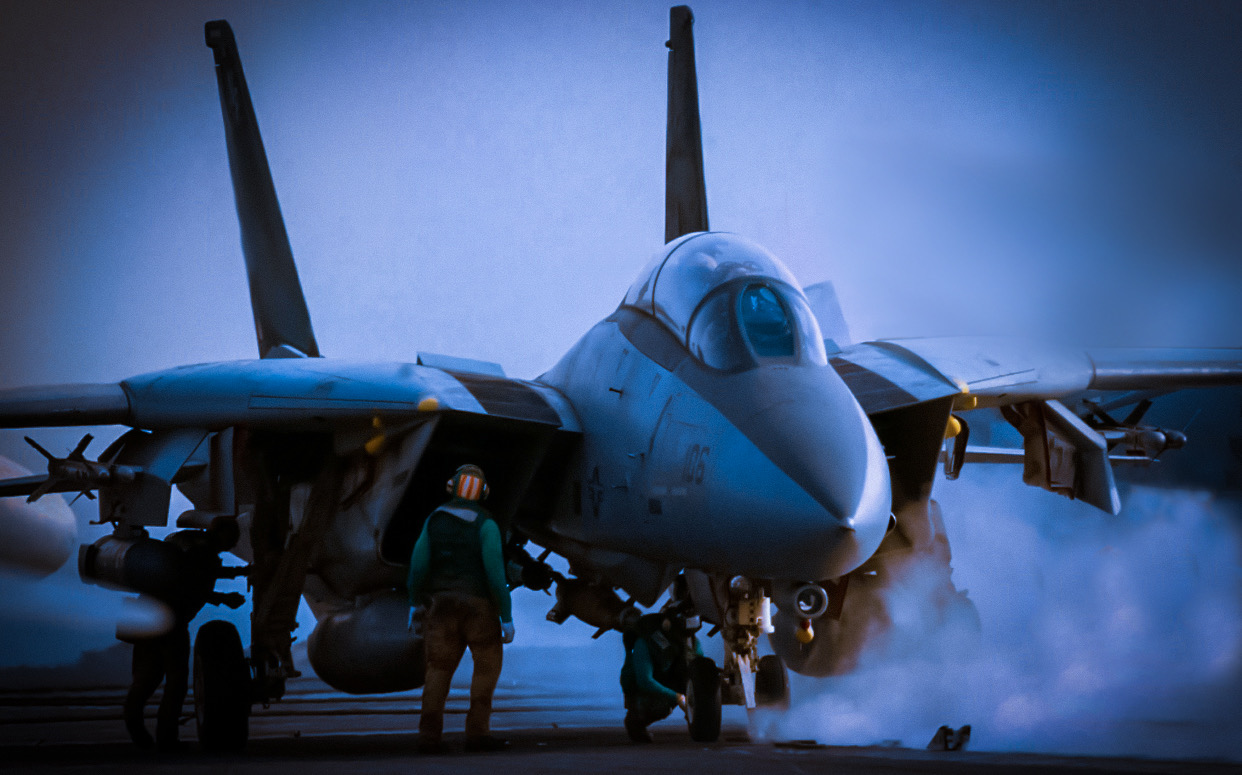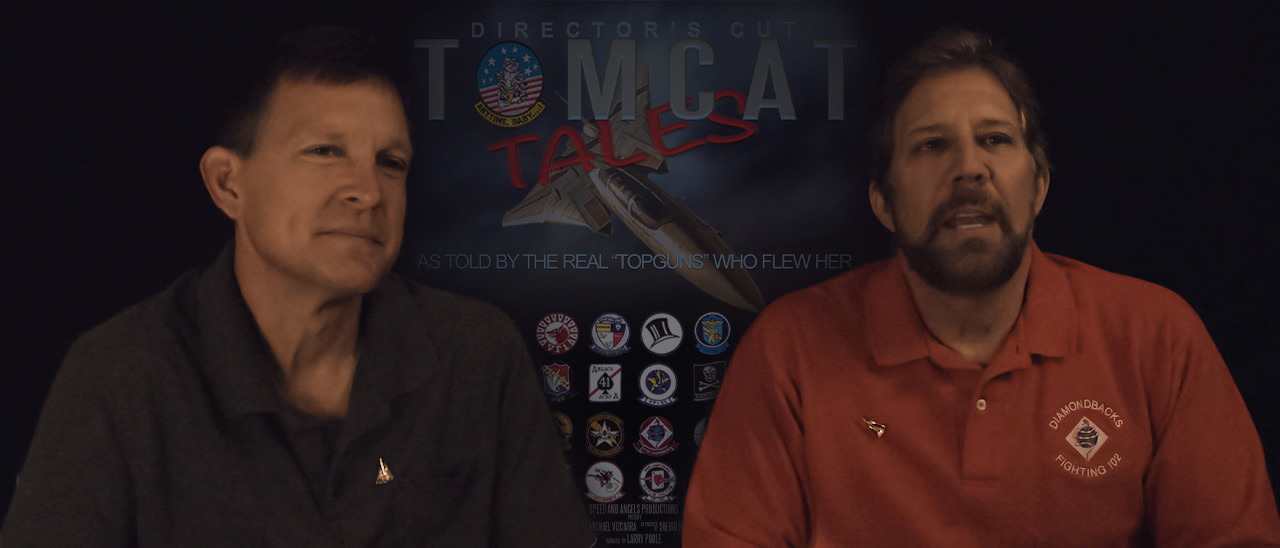‘As we were in the middle of Afghanistan with not enough fuel to get back to the ship, we put our emergency divert field in Pakistan on the nose,’ Michael Vizcarra, former F-14 Tomcat RIO.
Michael Vizcarra tells the story of a very unusual mission he flew during Operation Enduring Freedom. This story and many more are featured in the Bonus Features of the Tomcat Tales Blu-ray available at “www.f14tomcats.com”.
Having spent a relaxing academic year at the US Naval War College in lovely Newport, RI, I was anxious to get back to the excitement and camaraderie of the Tomcat community. In August 2001, I reported to the VF-102 Diamondbacks as Executive Officer to begin my command tour. Just weeks after joining the Diamondbacks, I was in our squadron-ready room at NAS Oceana watching in disbelief as the World Trade Center Twin Towers burned from the terrorist attacks of 9/11. Our deployment had already been scheduled for a Sep. 19, 2001 departure and I wondered how this would impact our scheduled deployment. We departed as planned on the USS Theodore Roosevelt heading east in anticipation of some kind of U.S. response. VF-102 was the single Tomcat squadron in Carrier Air Wing One flying F-14Bs with the very capable LANTIRN Pod that enabled the F-14 to employ laser-guided weapons.

Fast forward to Oct. 15, 2001: the USS Roosevelt, the first US aircraft carrier to deploy post 9/11, relieved the USS Enterprise in the Northern Indian Ocean. Two aircraft carriers (USS Enterprise and USS Vinson) were already on station to fly combat missions in support of “Operation Infinite Justice” which was almost immediately renamed “Operation Enduring Freedom”. With two aircraft carriers operating around the clock, one carrier was assigned to be the “day carrier” and the other the “night carrier” meaning their flight operations would be primarily during those hours. As new guys in the area, we were given the day carrier responsibilities.
On Oct. 18, I was scheduled for the second CVW-1 strike launched into Afghanistan from the USS Roosevelt. This would be the first and only mission throughout this entire combat cruise in that I would actually have a target file to brief for the flight. Our target was a military complex which included a support building and numerous tanks in the open yard. VF-102 led the brief of (2) Tomcats, each loaded with two GBU-16s, and (4) Hornets, each carrying 2 GBU-12s to attack this military complex near the capital city of Kabul, the largest city in Afghanistan. The Hornets were tasked with targeting the building as it would be easier to acquire the larger target with the lower resolution F-18 Nighthawk Pod. The Tomcats were assigned to target the numerous tanks in the yard.

With minimal notice, the strike was moved up 24 hours so we quickly briefed for a 09:00 am (local) launch. Launching in aircraft 104 (BUNO 161440), all was going as planned until we went through our weapons checks. We found both Tomcat LANTIRN pods were operationally degraded. The pod could still lase the target, but my LANTIRN would not accept the target coordinates despite numerous attempts to input them. So I was left with the “snowplow” mode which made target acquisition a bit more challenging as you must now visually find the target on the display and then designate as you fly near it. This was not an ideal scenario for the new XO who had minimal time operating the LANTIRN pod!
As we neared the target area, the Hornets dropped their bombs on their target (the building) as briefed. As smoke and dust now filled the air, the Tomcats attacked as the Hornets cleared the area. We attempted to designate our targets on the FLIR pod without success as we flew over the target. We quickly made the decision to circle and try again realizing that historically, most shoot-downs occur on the subsequent passes over the same target but we went for a second time (third if you count the Hornets’ pass). This time we designated the target and dropped it. However, we didn’t see the expected subsequent explosions and as we pulled up off target, our wingman informed us we had a “hung bomb” (a bomb that has failed to release for unknown reasons).
We saved up and figured we would try to get rid of the hung bomb over the water later. At least we were now on our way home to the Roosevelt! Our flight was originally scheduled as a 6-hour mission with 4 separate tanking evolutions; we tanked twice pre-target and now were proceeding outbound to the tanker track when the Air Force tanker announced that he had an engine fire and was leaving by the way, there are no other available tankers airborne!

As we were in the middle of Afghanistan with not enough fuel to get back to the ship, we put our emergency divert field in Pakistan on the nose. We had briefed the potential to divert but as this was early into the operation, no US aircraft had actually used this divert field yet. PAF Base Shahbaz near Jacobabad Pakistan had been home to the Pakistan Air Force F-16s at one time which is why it was considered a good divert for US fighters. The capability of the indigenous folks there to fuel and start an F-14 was seriously in question. The F-14 had no self start capability, it required external air equipment that would be used to turn the large GE F-110 engines to start. As we landed at the Pakistani base, we were hesitant to shut down the engines for fear they would not be able to find the right piece of gear to start us back up. With a huge language barrier and running on fumes, we finally had no choice but to shut down and hope this Tomcat wasn’t going to spend the rest of the war sitting on static display at this Pakistani air base. Getting out of the plane, the support crew motioned to us to move as fast as we could and later told us that locals around the base are not all that friendly to our cause and may try to take shots at us and the plane.
As the ranking officer, I was cordially invited to join the base Commanding General (a former MiG-19 pilot) in his office for tea. I spent the next two hours with a Pakistani General whose name I could not pronounce (I referred to him as “General T”) and relaxed over tea discussing everything from military aviation to family histories for what seemed like hours in his office. His command of the English language was pretty good but with a really thick accent. He must have been fairly bored in his job as he kept the discussion going as I listened or pretended to listen because all I was thinking about was how to get the plane back to the carrier as soon as possible.
Finally, the General said good luck and goodbye and I returned to find the plane refueled and what appeared to be the correct support gear with which to start the engines. Once again they told us: start up, taxi and take off as fast as possible and do a high speed/steep climb out so as not to be shot at by the locals. Good words of advice as we were once again homeward bound for the ship. Over two hours later, we finally trapped onboard, debriefed our strike mission and recharged our bodies with some food and rest…..we had been up 27 hours straight. Not feeling really good about my first OEF mission, I wondered were they all going to be like this?
Other awesome F-14 stories are featured in the documentary Tomcat Tales available to purchase here.
Photo by Lt. Bryan Fetter / U.S. Navy and Mark and Michael Vizcarra

